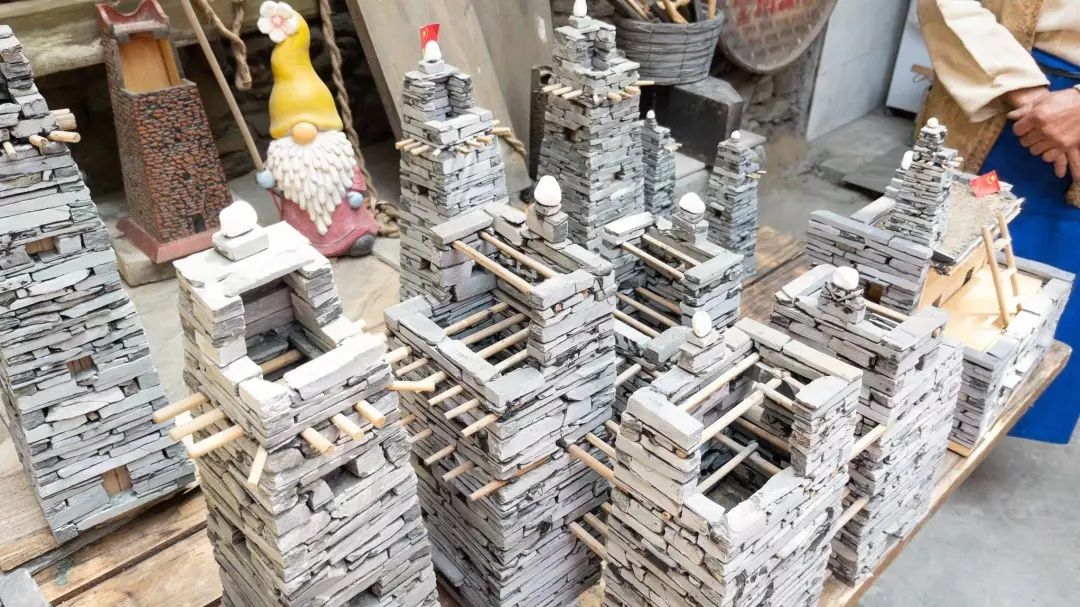11
2024.10
On a sweltering early autumn morning, streams of tourists meandered through the narrow corridors of a millennium-old stone-walled abode nestled in the mountains in southwest China, as if tracing the echoes of its storied past.
The abode, once home to the Qiang people from Taoping Qiang Village, has now become a popular scenic spot in Sichuan Province, drawing visitors from home and abroad.
Inside a cultural experience base, tourists were marveling at a diverse array of models of the local stone watchtowers, and some were experiencing the assembling of stone slabs into watchtower models.
 Small watchtower models made by Jia
Small watchtower models made by Jia
“We Qiang people used to live on herding, hunting and agriculture, but now tourism,” said Jia Xueyou, owner of the cultural experience base and also a resident of the village. “Tourism is less tiring and brings more income.”
Today, many Qiang people remain or have moved here for a better quality of life, receiving a 25 percent of dividend from annual ticket sales.
As an increasing number of Chinese are enthusiastic about traditional and ethnic cultures, tourism in ethnic minority areas have gained traction in recent years.
Films and TV series featuring ethnic elements also greatly boosted this fervor. Taoping Qiang Village has been the filming location of quite a few renowned movies, including Erma’s Wedding(2008), Design of Death(2012), and the Story of Tusi Chieftain(2019).
Buoyed by the booming tourism, Taoping villagers began tapping into their rich cultural heritage ranging from architecture to attire and music. For example, Qiang embroidery, an exquisite intangible cultural heritage, has become the hot cake with travelers.
 Local Qiang people play special musical instruments Kouqin and Qiangdi to visitors on the watchtower.
Local Qiang people play special musical instruments Kouqin and Qiangdi to visitors on the watchtower.
About 30 kilometers southwest to Taoping Qiang Village, a Tibetan village named Ganbao is also welcoming visitors worldwide.
Walking into the village, one will be greeted by a fluttering of prayer flags on distant hillsides. In the square, tourists dressed in Tibetan garments are eager to record their new looks.
“It's high season now, and there are lots of young people coming to take photos every day,” said a local costume provider.
Xiao Wang chose a Tibetan robe with her daughter. “I saw Tibetan costume on social media. They are so beautiful. After taking pictures, I want to enjoy some buttered tea and buy some souvenirs,” she said.
 A young girl dressed in Tibetan costume was taking photos in Ganbao Tibetan Village.
A young girl dressed in Tibetan costume was taking photos in Ganbao Tibetan Village.
Another highlight in Sichuan is Zhuokeji Official Chieftain Village, once the manor of a Tibetan tribal leader Tusi and the political heart his region. Situated along the bank of Suomo River, this stunning site has been hailed by the New York Times as “a jewel in the history of oriental architecture” for its aesthetic value.
Thanks to the government-led renovations, the village has been restored from ruins, vividly representing the art style and historical profundity of this region.
“The cultural relics inside reflect people’s way of life, the Tusi chieftain system, and Tibetan religion…Promoting such knowledge through this village is of great historic value,” said Zhaxi, a 33-year-old Tibetan tour guide.
Through diverse ethnic-cultural tourism, ethnic minorities in southwest China see a notable increase in their income. More importantly, the rich cultural heritage is better preserved, innovated, and promoted.
In Taoping Qiang Village, Jia's second daughter Yang Tianqun passionately shared the stories of the watchtowers with visitors. With her improved Mandarin, she has become a competent “cultural ambassador.”
“I hope that through our efforts, the Qiang culture can be known by more people in the future,” Yang said.
 Jia and Yang at their cultural experience base
Jia and Yang at their cultural experience base
文字、排版|高雨曦
图片|高雨曦

2023.08.14 13:45
05
2025.09
05
2025.09
09
2025.06
 28:32
28:32
2025.06.19 08:55